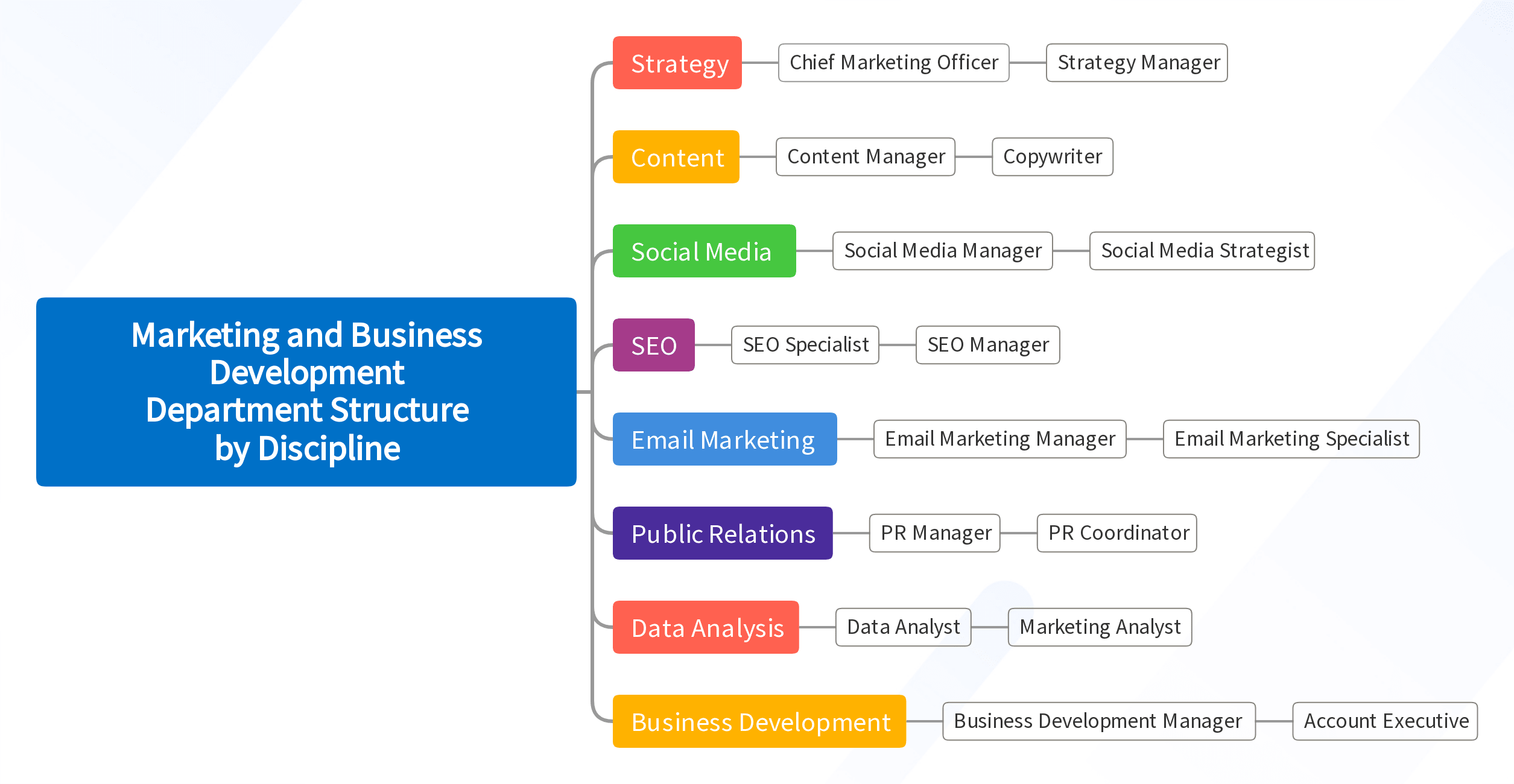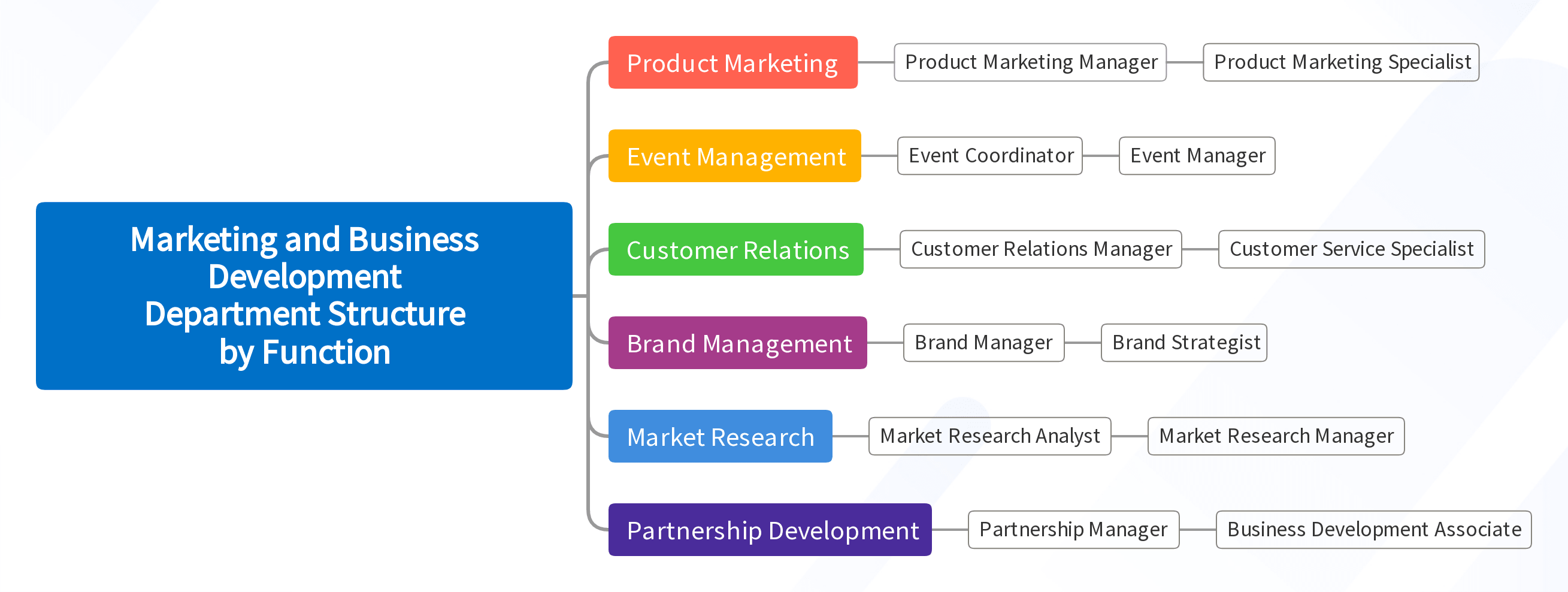

After running my own successful marketing agency, I’ve learned the importance of a marketing department structure.
Correctly structuring a marketing and business development team lays the groundwork for success. It ensures the necessary synergy to fuel growth and stand out in a competitive landscape.
Through my first-hand experience (and plenty of mistakes), I’ve learned what it takes to properly structure a marketing and business development dream team.
This guide shares key information about the marketing department structures and how to build the best one for your business.
Key Takeaways
- There are two primary ways to structure a marketing team: by function and by discipline. Each has its own set of advantages and is suitable for different types of businesses and stages of growth.
- Some of the key roles in marketing departments include Marketing Manager, Content Manager/Copywriter, Social Media Manager, and SEO Specialist.
- When determining the structure for your marketing team, consider your business goals, team size, budget, and company culture.
- The structure of a marketing team isn't static and should evolve with the company's growth and changes in the market.
Best for Growth Marketers
Best for Paid Ads & CMO's
Table of Contents
Types of Marketing Department Structures
There are two main types of department structures based on company size and resources.
- Structuring a marketing department by discipline
- Org Type: Traditional corporate departments
- Best For: Midsize/Enterprise companies
- Structuring a marketing team by function
- Org Type: Employees are grouped by activities and objectives
- Best For: Small to Medium Sized Business (SMB)
Let’s go in-depth to each one of them.
1. Marketing and Business Development Department Structure by Discipline


Discipline-based structure involves building teams centered around various marketing disciplines. For example, SEO, Content, Market Research, and Product Strategy could each form separate teams within a department.
| Discipline | Key Skills | Potential Roles |
|---|---|---|
| Strategy | Strategic Planning, Market Analysis, Competitive Analysis | Chief Marketing Officer, Strategy Manager |
| Content | Copywriting, SEO, Blogging, Content Strategy | Content Manager, Copywriter |
| Social Media | Social Media Management, Content Creation, Engagement Analysis | Social Media Manager, Social Media Strategist |
| SEO | Keyword Research, On-Page SEO, Link Building | SEO Specialist, SEO Manager |
| Email Marketing | Copywriting, Email Strategy, Analytics | Email Marketing Manager, Email Marketing Specialist |
| Public Relations | Media Relations, Crisis Management, Event Coordination | PR Manager, PR Coordinator |
| Data Analysis | Data Mining, Statistical Analysis, Predictive Modeling | Data Analyst, Marketing Analyst |
| Business Development | Sales, Relationship Management, Negotiation | Business Development Manager, Account Executive |
Pros
- Comprehensive Skill Development: Team members can develop a broad range of skills across various marketing disciplines, making them more versatile and adaptable.
- Integrated Strategy Implementation: A discipline-based structure facilitates a more integrated marketing approach. Team members are encouraged to consider how different disciplines interact and complement each other.
- Flexibility and Adaptability: Teams can be more flexible and quickly adapt to changes in marketing strategies or market conditions, as members have a broader understanding of different disciplines.
- Encourages Innovation: Exposure to multiple disciplines can foster creativity and innovation, as team members can draw on a wider range of ideas and perspectives.
- Holistic Understanding of Marketing: Team members gain a holistic understanding of marketing, which can lead to more strategic thinking and better alignment with overall business objectives.
Cons
- Jack of All Trades, Master of None: Team members might become generalists without deep expertise in any one area. It could lead to a lack of specialized knowledge where it's needed.
- Coordination Challenges: Coordinating activities across multiple disciplines can be complex and time-consuming, especially if the team lacks clear leadership or direction.
- Potential for Role Confusion: With clear definitions of roles and responsibilities, there might be clarity and clarity in what is expected from each team member. This leads to inefficiencies.
- Resource Allocation Challenges: Allocating resources effectively is a challenge, as it might be difficult to determine which disciplines should be prioritized.
2. Marketing and Business Development Department Structure by Function


Another approach is structuring by function, where teams are formed based on the different functions they perform. For example, promotion, launches, and relationship management could all be separate teams.
| Function | Key Skills | Potential Roles |
|---|---|---|
| Product Marketing | Product Knowledge, Positioning Strategy, Market Research | Product Marketing Manager, Product Marketing Specialist |
| Event Management | Event Planning, Vendor Management, Logistics | Event Coordinator, Event Manager |
| Customer Relations | Customer Service, Retention Strategies, CRM Software | Customer Relations Manager, Customer Service Specialist |
| Brand Management | Brand Strategy, Brand Awareness, Creative Thinking | Brand Manager, Brand Strategist |
| Market Research | Data Collection, Market Analysis, Survey Design | Market Research Analyst, Market Research Manager |
| Partnership Development | Relationship Building, Negotiation, Strategic Planning | Partnership Manager, Business Development Associate |
Pros
- Specialized Expertise: Each team focuses on a specific function (e.g., content marketing, social media, SEO). Members develop deep expertise and skills in that area.
- Clear Responsibilities: Clear delineation of roles and responsibilities leads to fewer overlaps and misunderstandings, ensuring that each function is fully accounted for.
- Efficient Resource Allocation: Scaling each function according to the business needs allows efficient resource allocation.
- Easier Performance Tracking: It's easier to track and measure the performance of each function. Specific KPIs can be set for each team based on their unique goals and responsibilities.
- Enhanced Collaboration within Functions: Team members within the same function will likely have similar skill sets and objectives. This fosters a collaborative environment where members can easily share insights and best practices.
Cons
- Siloed Operations: Teams may become too focused on their specific function, leading to silos that hinder cross-functional collaboration.
- Potential for Duplication: There might be duplication of efforts across functions, especially in areas where their responsibilities overlap, such as content creation for SEO and social media.
- Inflexibility: The structure might become inflexible, making it difficult to adapt quickly to changes requiring a more integrated approach.
- Communication Barriers: Communication between different functional teams may be less frequent. It can lead to a lack of shared understanding and potential misalignment with overall marketing goals.
- Dependency Issues: Over-specialization might lead to dependency on certain teams, causing bottlenecks and delays if one team is not functioning optimally
Common Marketing Department Roles
Here’s a closer look at some of the top marketing department roles you may need:
Marketing Manager
The Marketing Manager oversees the entire marketing department. Their responsibilities include:
- managing the marketing budget
- developing effective plans and strategies
- coordinating various marketing activities.
They are visionaries with a deep understanding of market trends. They must possess both creative and analytical skills to drive the department's success.
Content Manager/Copywriter
Content Managers and Copywriters are responsible for creating compelling and relevant content that engages the target audience.
This includes:
- blog posts
- social media content
- product descriptions
- Email newsletters
- Website content
- Whitepapers
- And more
They are skilled storytellers with knowledge of, SEO. Marketing writers adapt their writing style to fit the brand's voice and objectives.
Social Media Manager
Social Media Managers develop and implement strategies for the brand's presence on various social media platforms.
Their responsibilities include:
- creating content
- scheduling posts
- engaging with the audience
- analyzing social media performance.
Their goal is to increase brand awareness, generate leads, and foster community engagement.
SEO Specialist
SEO Specialists focus on improving the company's organic search rankings and overall online visibility.
They:
- conduct keyword research
- optimize website content
- develop link-building strategies.
Their expertise helps ensure that the brand’s target audience can easily discover them via search engines.
Email Marketing Manager/Specialist
Email Marketing Managers design and execute email campaigns to communicate with customers and prospects.
They:
- manage subscriber lists
- create engaging email content
- segment audiences
- analyze campaign performance.
Their role is crucial in nurturing leads, driving conversions, and retaining customers.
Public Relations Manager/Coordinator:
PR Managers or Coordinators handle the brand's public image and relationships with the media.
They
- develop PR strategies
- manage press releases
- organize events
- handle crisis communications.
Their work ensures a positive brand reputation and effective communication with the public and stakeholders.
Data Analyst/Marketing Analyst
Marketing Data Analysts collect and interpret data from various marketing campaigns and customer interactions.
They provide insights into customer behavior, campaign performance, and market trends.
Their analysis informs strategic decisions and helps optimize marketing efforts for better results.
Determining the Ideal Marketing Department Size
To achieve successful marketing outcomes, you need to align the team size with your business's scale – a strategic approach that helps optimize resources and drive targeted growth.
| Business Scale | Ideal Department Size | Explanation |
|---|---|---|
| Start-up | 2-5 | Lesser complexities, limited budget, and fewer tasks. |
| Small-Medium Business | 6-20 | Increased tasks, stable capital, and moderate market reach. |
| Large Enterprise | 21+ | Global operations, diverse tasks, and extensive market reach. |
Step-by-Step Guide for Structuring a Marketing Team
Evaluate Your Business Goals
Understand your company's objectives. What are you hoping to achieve with your marketing and business development efforts? The structure should align with and support these goals.
Skills and Expertise
Consider the skills and knowledge that your team currently possesses. Identify any gaps that need to be filled to execute your marketing and business development strategies effectively.
Assess Your Budget Constraints
Your financial resources will play a significant role in determining the structure. Make sure to balance the need for various roles and services with the budget you have at your disposal.
Evaluate Fit with Your Company Culture
The structure of your team should reflect your company's culture. A collaborative culture might benefit from a flat structure, while a more hierarchical culture might require a traditional top-down structure.
Consider Market Dynamics
The business environment and market trends can influence your department structure. Stay adaptable and be ready to evolve your structure to meet changing market demands.
Explore other marketing departments:
- Sales and Marketing Team Structure
- B2B SaaS Marketing Team Structure
- Recruitment Marketing Team Structure
Structuring Your Marketing Department- The Final Verdict
Each role in your marketing department plays a pivotal part in driving your brand's success. You must evaluate your business needs and budget to determine the best structure for your needs. Be sure to align your marketing department size with your business size for an affordable solution.
For more in-depth marketing and business insights, sign up for the DDIY.co newsletter. Stay ahead of the curve with the latest trends and tips delivered straight to your inbox!
FAQs
What is the difference between structuring a marketing team by function and by discipline?
Structuring by function involves organizing teams based on specific marketing functions like SEO, content marketing, or social media. Structuring by discipline, however, involves a more integrated approach where team members are knowledgeable across various marketing disciplines.
What is the best way to structure a marketing team?
Discipline-based marketing teams are ideal for medium to enterprise traditional corporate businesses. Functional marketing departments work best for small to medium businesses where employees are in objective-based teams.
How do I determine the right structure for my marketing team?
The right structure depends on several factors including your business size, goals, industry, and the skills of your team members. Consider your current and future marketing needs, and be prepared to adapt as those needs change.
What makes up a marketing team?
Marketing teams include a mix of individuals with different skills and responsibilities who collaborate to increase brand awareness, sales, and other company-wide marketing goals.
How big should my marketing department be?
The marketing department size should be scaled according to your business size. The ideal size for a startup is 2-5 people. For a small to medium business, it is 6-20 members, and for a large enterprise, it’s 21+.
Can the structure of a marketing team evolve?
Absolutely. As your business grows and the market changes, your marketing team's structure may need to evolve. Regularly assess the effectiveness of your team structure and be open to reorganizing roles and responsibilities.


















